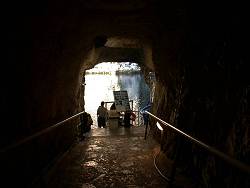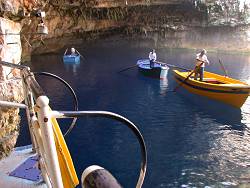Λιμνη Μελισσανη
Limni Melissani - Melissani Lake - Cave of Melissani
Useful Information


| Location: |
Karavomilos 280 80.
At Karavomilos, Island Cephalonia, Ionian Islands. Karavomilos is a small village northwest of Sami. The road from Sami to the north goes through Karavomilos. Turn left at the end of Karavomilos. 200 m to the cave. Well signposted around Sami. (38.2567916, 20.6243429) |
| Open: |
01-NOV to 03-APR Thu, Sat, Sun 10-16. 01-MAY to 30-OCT daily 9-19. [2024] |
| Fee: |
Adults EUR 10, Children (6-18) EUR 5, Children (0-5) free, Students EUR 5, Seniors (65+) EUR 5, Disabled free, Unemployed free. Combo Ticket with Drogarati Cave: Adults EUR 13, Children (6-18) EUR 10, Children (0-5) free, Students EUR 10, Seniors (65+) EUR 10, Disabled free, Unemployed free. Plus tip for the gondolier. [2024] |
| Classification: |
 Karst Cave. Karst Cave.
 Kefalonia-Ithaca UNESCO Global Geopark
Upper Cretaceous limestones. Kefalonia-Ithaca UNESCO Global Geopark
Upper Cretaceous limestones.
|
| Light: |
 Incandescent Incandescent
|
| Dimension: |
L=150 m, W=60 m, VR=36 m. Doline opening: L=50 m, W=30 m. Water: max depth 30 m. |
| Guided tours: | boat trip. D=15 min. |
| Photography: | allowed |
| Accessibility: | no |
| Bibliography: |
Evridiky Livada-Douka, Destounis Haralambos (o.J.):
Melissani,
Adam, Athens.



Dr. Joseph Partsch (1890): Kephallenia und Ithaka - eine geographische Monographie, Ergänzungsheft No. 98 zu Petermann’s Mitteilungen, Gotha: Justus Perthes, 1890 online |
| Address: |
Limni Melissani, Karavomilos, Cephalonia, Tel: +30-2674-022997.
Municipality of Sami, 27 Ioannou Metaxa Ave, Sami, 28080 Kefalonia, Tel: +30-2674-360-500. |
| As far as we know this information was accurate when it was published (see years in brackets), but may have changed since then. Please check rates and details directly with the companies in question if you need more recent info. |
|
History
| 1890 | mentioned by Dr. Joseph Partsch in his monography Kephallenia und Ithaka. |
| 1951 | first exploration by Ioannis Petrocheilos, discovery of an ancient lamp on the central hill. |
| 1959 | dye tracing experiments by Ioannis Petrocheilos, Maurin, and Zölt revealed the connection to the Kathavothres. |
| 1962 | excavations on the central hill. |
| 1963 | entrance tunnel built, cave opened to the public. |
Description




Λιμνη Μελισσανη (Limni Melissani, Melissani Lake), as the name suggests, is a nice lake with boats, but this lake is inside a cave. It is also named Σπήλαιο Μελισσάνης (Spilaio Melissani, Melissani Cave). The water-filled cave passage is about 30 m wide, but here it widened further forming two big chambers. They gre The cavern, once two big chambers, caved in several thousand years ago. Today the cave has the shape of a B, with two big water filled halls and an island in the middle. The first hall has a big oval opening to the surface, where the sunlight shines in. When the sun is directly overhead, its rays strike the ultramarine water, lighting the cave with blue light. So the best time to visit the cave is on a sunny day at the middle of the day. Nevertheless, a visit in the morning or in the evening has its own atmosphere. The boats seem to hover on a lake of blue light.
The cave is entered through an artificial tunnel, which ends at a very small pier. The boats are on the lake all the time, waiting for visitors. When visitors arrive at the pier, one of the boats lands and lets them embark. The complete tour is done by boat, first making a round trip around the first hall with the hole in the roof. Then the boat passes the island on the opposite wall, where a small channel exists. This channel is too narrow to row, but there is a rope along the wall and the gondolier pulls the boat through. The second hall is a huge chamber with a vaulted roof, which was also created by the collapse of the ceiling, but this part of the cave is located towards the centre of the island, towards the slope, so the cover is thicker and the ceiling has not collapsed. Now it seems the incasion of the ceiling has come to an end, it forms a pretty perfect dome which should be rather stable. The second chamber has numerous big stalactites which are green from algae and moss. With the daylight coming in, this is not a big surprise. And despite their size, they look minute in the big dome. This chamber is lit with electric light, unfortunately only yellow lamps, rather typical for Greek caves and giving this part of the cave a sick look.
The island is not visited during the tour, people are not allowed to leave the boat. There are some stalagmites on the debris pile, but they are also green and unimposing. But the island is rather interesting for the archaeological remains found here. During the first exploration in 1951, an ancient lamp, which is now on display in the Archaeological Museum of Argostoli, was found there.
The excavations of 1962 were made by S. Marinos and produced few but important relics of a former Minoan culture on Cephalonia. Oil lamps, plates and figures show the god Pan and several nymphs. This is, why the cave is sometimes called Cave of the Nymphs, but this is a bit confusing, as there are dozens of nymph caves in Greece. However, the lake was named after one of the nymphs, the nymph Melissanthi.
An artificial balcony offers an enchanting view from the top of the cave. Unfortunately, this balcony is now closed to the public. The hole was fenced rather freehand, including the balcony, and so there is now no chance to see the cave despite the cave visit. Knowing a bit about the intensive Greek urge for security measures, we suppose financial interests behind this fence. The cave trip is the most expensive of all Greek caves reviewed, especially if the tip for the gondolier is included.
Lake Melissani has an absolute invisible specialty, which sounds pretty strange.
The lake water is brackish, a mixture of seawater and sweet water.
The cave is about 500 m from the sea, and the water level is a metre higher than sea level, and the brackish water rises from a 30 m deep cave system on one side of the cave and flows silently to the other end of the cave, flowing through narrow crivices into the sea.
Here the water from the
 Katavothres
on the other side of the Island reappears.
This was discovered by dye tracing experiments in 1959.
For a detailed explanation of this unique geological structure, have a look at the
Katavothres
on the other side of the Island reappears.
This was discovered by dye tracing experiments in 1959.
For a detailed explanation of this unique geological structure, have a look at the
 Katavothres
page.
Katavothres
page.
Lake Melissani Cave is Geosite No 25 of the
 Kefalonia-Ithaca UNESCO Global Geopark.
Kefalonia-Ithaca UNESCO Global Geopark.
- See also
 Katavothres
Katavothres Search DuckDuckGo for "Limni Melissani"
Search DuckDuckGo for "Limni Melissani" Google Earth Placemark
Google Earth Placemark OpenStreetMap
OpenStreetMap Melissani Cave - Wikipedia (visited: 31-OCT-2024)
Melissani Cave - Wikipedia (visited: 31-OCT-2024) Mellisani Underground Lake
Mellisani Underground Lake Εισιτήρια Δρογκαράτης - Μελισσάνης, official website (visited: 31-OCT-2024)
Εισιτήρια Δρογκαράτης - Μελισσάνης, official website (visited: 31-OCT-2024) Melissani Cave, inofficial website (visited: 31-OCT-2024)
Melissani Cave, inofficial website (visited: 31-OCT-2024) Melissani (visited: 31-OCT-2024)
Melissani (visited: 31-OCT-2024) Die Melissanihöhle bei Sami, Kefalonia, GR (visited: 28-JUL-2011) by Franz Lindenmayr. (
Die Melissanihöhle bei Sami, Kefalonia, GR (visited: 28-JUL-2011) by Franz Lindenmayr. ( )
) The World’s Six Most Beautiful Lakes | All That Is Interesting (visited: 18-NOV-2011)
The World’s Six Most Beautiful Lakes | All That Is Interesting (visited: 18-NOV-2011)

 Index
Index Topics
Topics Hierarchical
Hierarchical Countries
Countries Maps
Maps